THUNDER BAY - A new project aimed at supporting vulnerable and at-risk youth in the city of Thunder Bay received more than $5 million in funding from the federal government.
“This is the culmination of a whole lot of time and effort and dedication to something we really believe is critical to our community - providing opportunities to youth so they are safe and so they can thrive,” said Lee-Ann Chevrette, Crime Prevention Council coordinator with the city of Thunder Bay.
The Youth Inclusion Program will receive $5.6 million in funding over five years as part of the National Crime Prevention Strategy. The funding comes in response to the recommendations of the Seven Youth Inquest to examine the deaths of seven Indigenous youth from remote First Nation communities between 2000 and 2011.
With more than 20 partnering organizations involved, the project will help youth between the ages of 12 and 24-years-old connect with programming and services in the city to reduce crime and victimization, with a special focus on Indigenous youth.
Three program sites have been chosen, which include the Simpson/Ogden area, the Windsor/Picton/Blucher area, and the Vale/Limbrick area. It will also include two school sites at Dennis Franklin Cromarty High School and the Matawa Learning Centre and a mobile unit.
The funding will be used over five years to hire full and part-time staff to be present at specific sites to connect youth to opportunities and services, hiring youth navigators, engaging youth in recreational and cultural programming, increasing knowledge and skills, making connections to youth in remote northern communities, and reducing interactions with the justice system.
“The vision ultimately is to keep all youth in Thunder Bay safe and connected to a diverse range of opportunities for them to thrive,” Chevrette said.
Minister Patty Hajdu said the funding is in response to the Seven Youth Inquest that specifically talked about the need for better youth supports in the city, particularly for Indigenous youth.
“This is a very specific response to a very specific call,” she said. “There is no one size fits all solution to this, but making sure we have flexibility in the programming that meets the needs of kids as the needs evolve.”
“The money, at the end of the day, is about making sure every young person, including vulnerable Indigenous people feel like they are part of this community, feel like they have places to go when they are struggling, and feel like they have alternatives to unhealthy communities that exist in pockets of our community that prey on young people who are feeling vulnerable,” Hajdu continued.
Hajdu recognizes that $5.6 million is a significant investment, which represents the scope of this project, but she added that youth programming needs adequate resources in order to be successful, and it should not be looked at as money spent, but rather an investment into the future.
“The return on our investment is healthy young people that have managed to make it through education, who are working in their chosen profession, that are contributing back to their community,” she said.
That investment will go a long way to helping students at the Matawa Learning Centre achieve success, said Principal Brad Battiston.
“This is a wonderful opportunity and it is a major step toward helping the students feel comfortable and helping the students integrate into the city much more easily than previous years,” he said.
Battiston said the Youth Inclusion Program will help students from remote communities feel more connected throughout the city through enhancements to recreation, sport, volunteering, and cultural opportunities.
“This is a way to actually put significant financial muscle behind a process that has existed informally for a number of years, but it allows us to actually structure a program that goes well beyond anything we’ve actually been able to do before,” he said.
According to Chevrette, hiring of staff and preparing elements of the Youth Inclusion Program will be ongoing for the next four or five months, with the launch of the first site expected to take place in January.
